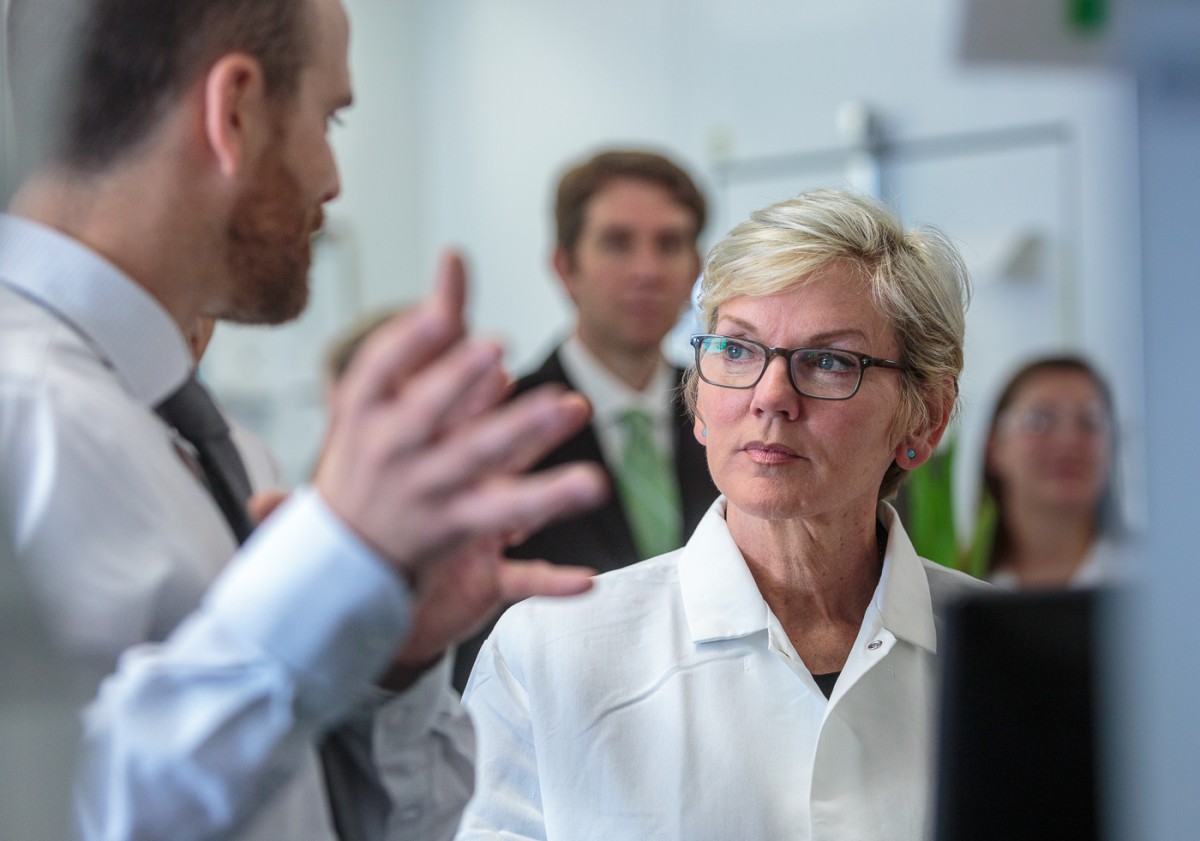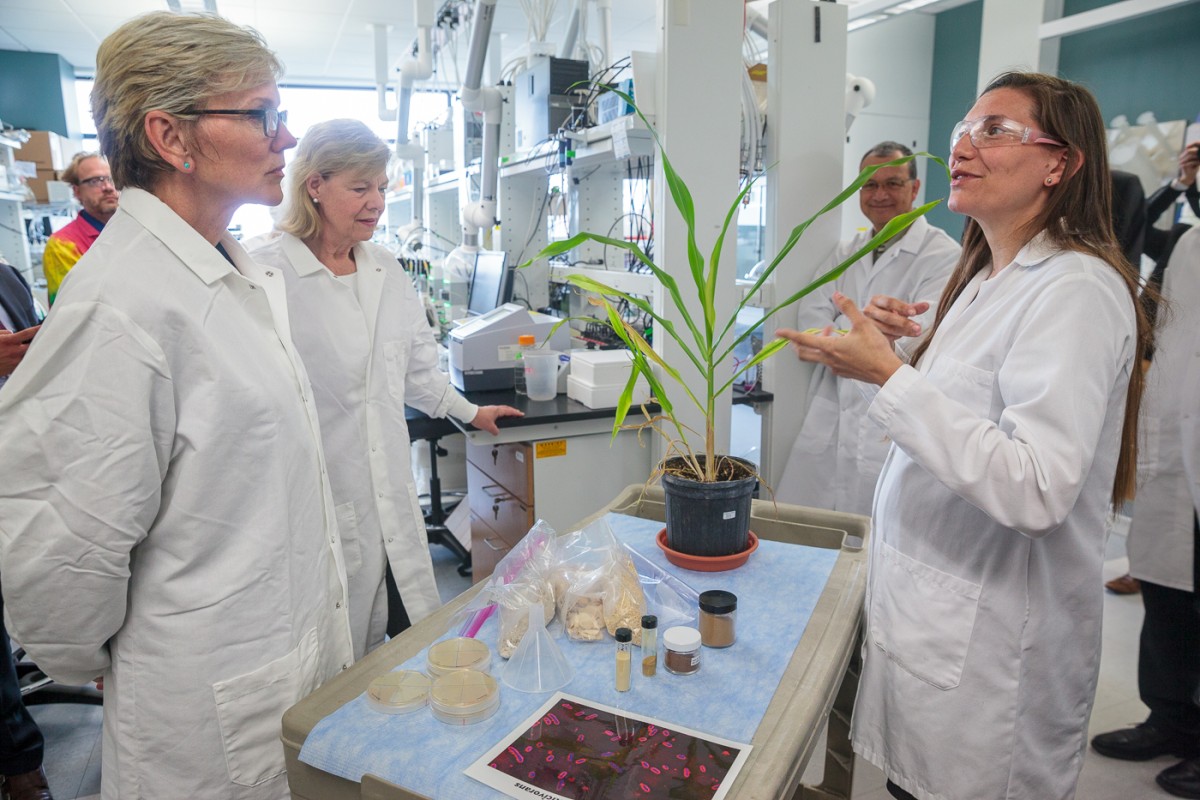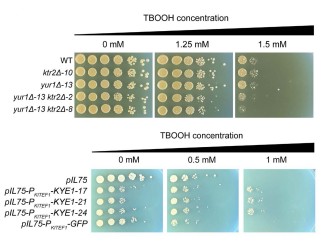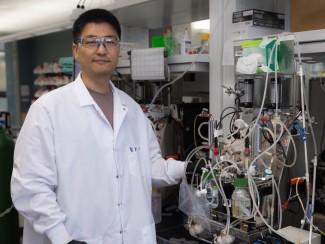Granholm, Baldwin tour GLBRC to learn about fundamental research on biofuels and bioproducts

The nation’s top energy official visited the University of Wisconsin–Madison Friday to see how scientists at the federally-funded Great Lakes Bioenergy Research Center are working to turn plants into sustainable and economical replacements for fossil fuels and petrochemicals.
U.S. Energy Secretary Jennifer Granholm, accompanied by Sen. Tammy Baldwin of Wisconsin, toured a fourth-floor laboratory in the Wisconsin Energy Institute, where senior scientist Trey Sato displayed a bundle of dried switchgrass, one of the perennial plants being studied as a source of low-carbon fuel.
Biofuels are a key component of the Biden administration’s plans to decarbonize the transportation sector and advance a sustainable, safe and secure bioeconomy. While electric vehicles will play a leading role, electrification isn’t practical for some heavy equipment, ships, and commercial aviation.
Granholm said GLBRC’s biofuel research is laying the groundwork for technologies that will help move the nation toward a “net-zero economy.”
“One of the things that they’re solving for is how to make sure that you can fly planes using what's known as sustainable aviation fuels. That means fuels that are from plants like switchgrass,” Granholm said. “That is a huge source of carbon pollution that will be eliminated. So that to me is very, very exciting.”

Sato explained the challenges of breaking down fibrous plants into carbohydrates and other chemicals that can be converted into valuable products with the help of microbes.
That includes finding ways to get brewer’s yeast – known as Saccharomyces cerevisiae – to digest xylose, a type of sugar they don’t naturally eat, in addition to the glucose they prefer.
“Saccharomyces cerevisiae looks at xylose kind of like my teenage children look at broccoli,” Sato said. “My lab’s challenge is to try to manipulate our Saccharomyces cerevisiae yeast to eat the broccoli as if they're eating ice cream.”
Other scientists detailed how their teams are working to understand the environmental impacts of energy crops, how to engineer plant strains that can be more easily broken down, and how to make biorefineries environmentally and economically sustainable, in part by extracting the most value from the plants.
A collaborative effort between UW–Madison, Michigan State University and other institutions, GLBRC was established in 2007 with a grant from the Department of Energy’s Office of Science.
In March, DOE committed to another five years of funding for GLBRC. The center will receive $27.5 million this year and up to $147.5 million over the life of the award.
The funding will allow GLBRC scientists to continue foundational research to enable breakthroughs needed for the cost-effective conversion of nonfood plants into low-carbon replacements for liquid fuels as well as plastics, lubricants and other products made from petroleum.
“I know firsthand how rich the Great Lakes region is with talented, driven problem-solvers, and the University of Wisconsin–Madison is home to an incredible group working to solve some of the biggest hurdles toward decarbonization,” Granholm said.

Since its inception GLBRC has provided a training home for more than a thousand students and staff and yielded more than 1,750 scientific publications, 264 patent applications, 113 licenses or options and five startup companies.
Baldwin linked those discoveries to economic development in Wisconsin and beyond.
“If they become feasible for commercialization that is all about new jobs, new businesses, and growth,” Baldwin said. “We heard a number of examples where research done in laboratories here on this campus and here in this building, have created the opportunity for startups and employment.”
While it is the university’s largest federally-funded project, GLBRC is one of more than 230 ongoing campus research efforts supported by more than $430 million from DOE.
“Two of the companies that we met with are spinouts from the University of Wisconsin at Madison on fusion energy, which of course is abundant, clean, and zero-carbon energy, and if we can crack the code on how to do that, we will resolve a whole lot of problems,” Granholm said. “So all sorts of problems (are) being resolved here at the University of Wisconsin.”
Granholm is the second cabinet secretary to visit the university this month.
U.S. Secretary of Veterans Affairs Denis R. McDonough met with Chancellor Mnookin on June 6 and held a roundtable discussion with students on issues affecting veterans.

About GLBRC
One of four DOE-funded bioenergy research centers, the cross-disciplinary center brings together biologists, chemists, engineers and economists, employing more than 450 researchers, students and staff conducting foundational research.
The center’s scientists have shown how changes in agricultural practices can lower net greenhouse gas emissions, used genomic maps of switchgrass varieties to increase yields of this key energy crop, modified trees to increase value and lower the cost of processing and discovered how to turn agricultural residues into polyesters, plastics and other polymers.





